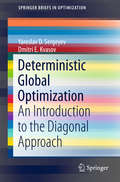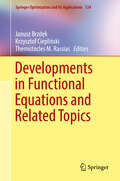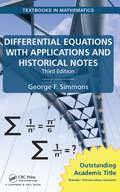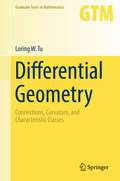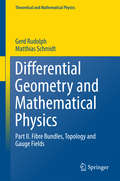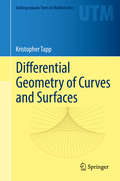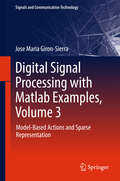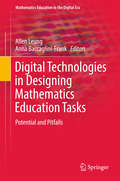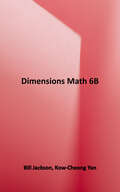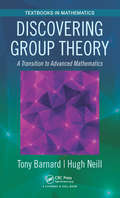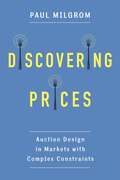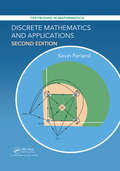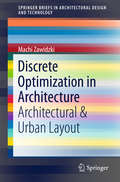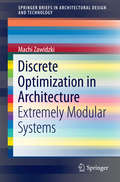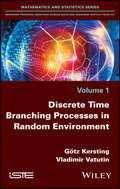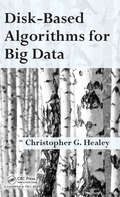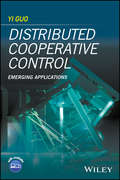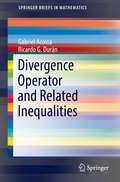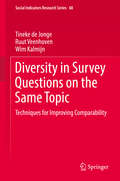- Table View
- List View
Deterministic Global Optimization
by Yaroslav D. Sergeyev Dmitri E. KvasovThis book begins with a concentrated introduction into deterministic global optimization and moves forward to present new original results from the authors who are well known experts in the field. Multiextremal continuous problems that have an unknown structure with Lipschitz objective functions and functions having the first Lipschitz derivatives defined over hyperintervals are examined. A class of algorithms using several Lipschitz constants is introduced which has its origins in the DIRECT (DIviding RECTangles) method. This new class is based on an efficient strategy that is applied for the search domain partitioning. In addition a survey on derivative free methods and methods using the first derivatives is given for both one-dimensional and multi-dimensional cases. Non-smooth and smooth minorants and acceleration techniques that can speed up several classes of global optimization methods with examples of applications and problems arising in numerical testing of global optimization algorithms are discussed. Theoretical considerations are illustrated through engineering applications. Extensive numerical testing of algorithms described in this book stretches the likelihood of establishing a link between mathematicians and practitioners. The authors conclude by describing applications and a generator of random classes of test functions with known local and global minima that is used in more than 40 countries of the world. This title serves as a starting point for students, researchers, engineers, and other professionals in operations research, management science, computer science, engineering, economics, environmental sciences, industrial and applied mathematics to obtain an overview of deterministic global optimization.
Developments in Functional Equations and Related Topics (Springer Optimization and Its Applications #124)
by Janusz Brzdęk, Krzysztof Ciepliński and Themistocles M. RassiasThis book presents current research on Ulam stability for functional equations and inequalities. Contributions from renowned scientists emphasize fundamental and new results, methods and techniques. Detailed examples are given to theories to further understanding at the graduate level for students in mathematics, physics, and engineering.Key topics covered in this book include:Quasi meansApproximate isometriesFunctional equations in hypergroupsStability of functional equationsFischer-Muszély equationHaar meager sets and Haar null setsDynamical systemsFunctional equations in probability theoryStochastic convex orderingDhombres functional equationNonstandard analysis and Ulam stabilityThis book is dedicated in memory of Staniłsaw Marcin Ulam, who posed the fundamental problem concerning approximate homomorphisms of groups in 1940; which has provided the stimulus for studies in the stability of functional equations and inequalities.
Differential Equations with Applications and Historical Notes (Textbooks in Mathematics)
by George F. SimmonsFads are as common in mathematics as in any other human activity, and it is always difficult to separate the enduring from the ephemeral in the achievements of one’s own time. An unfortunate effect of the predominance of fads is that if a student doesn’t learn about such worthwhile topics as the wave equation, Gauss’s hypergeometric function, the gamma function, and the basic problems of the calculus of variations—among others—as an undergraduate, then he/she is unlikely to do so later. The natural place for an informal acquaintance with such ideas is a leisurely introductory course on differential equations. Specially designed for just such a course, Differential Equations with Applications and Historical Notes takes great pleasure in the journey into the world of differential equations and their wide range of applications. The author—a highly respected educator—advocates a careful approach, using explicit explanation to ensure students fully comprehend the subject matter. With an emphasis on modeling and applications, the long-awaited Third Edition of this classic textbook presents a substantial new section on Gauss’s bell curve and improves coverage of Fourier analysis, numerical methods, and linear algebra. Relating the development of mathematics to human activity—i.e., identifying why and how mathematics is used—the text includes a wealth of unique examples and exercises, as well as the author’s distinctive historical notes, throughout. Provides an ideal text for a one- or two-semester introductory course on differential equations Emphasizes modeling and applications Presents a substantial new section on Gauss’s bell curve Improves coverage of Fourier analysis, numerical methods, and linear algebra Relates the development of mathematics to human activity—i.e., identifying why and how mathematics is used Includes a wealth of unique examples and exercises, as well as the author’s distinctive historical notes, throughout Uses explicit explanation to ensure students fully comprehend the subject matter Outstanding Academic Title of the Year, Choice magazine, American Library Association.
Differential Geometry
by Loring W. TuThis text presents a graduate-level introduction to differential geometry for mathematics and physics students. The exposition follows the historical development of the concepts of connection and curvature with the goal of explaining the Chern-Weil theory of characteristic classes on a principal bundle. Along the way we encounter some of the high points in the history of differential geometry, for example, Gauss' Theorema Egregium and the Gauss-Bonnet theorem. Exercises throughout the book test the reader's understanding of the material and sometimes illustrate extensions of the theory. Initially, the prerequisites for the reader include a passing familiarity with manifolds. After the first chapter, it becomes necessary to understand and manipulate differential forms. A knowledge of de Rham cohomology is required for the last third of the text. Prerequisite material is contained in author's text An Introduction to Manifolds, and can be learned in one semester. For the benefit of the reader and to establish common notations, Appendix A recalls the basics of manifold theory. Additionally, in an attempt to make the exposition more self-contained, sections on algebraic constructions such as the tensor product and the exterior power are included. Differential geometry, as its name implies, is the study of geometry using differential calculus. It dates back to Newton and Leibniz in the seventeenth century, but it was not until the nineteenth century, with the work of Gauss on surfaces and Riemann on the curvature tensor, that differential geometry flourished and its modern foundation was laid. Over the past one hundred years, differential geometry has proven indispensable to an understanding of the physical world, in Einstein's general theory of relativity, in the theory of gravitation, in gauge theory, and now in string theory. Differential geometry is also useful in topology, several complex variables, algebraic geometry, complex manifolds, and dynamical systems, among other fields. The field has even found applications to group theory as in Gromov's work and to probability theory as in Diaconis's work. It is not too far-fetched to argue that differential geometry should be in every mathematician's arsenal.
Differential Geometry and Mathematical Physics
by Matthias Schmidt Gerd RudolphThe book is devoted to the study of the geometrical and topological structure of gauge theories. It consists of the following three building blocks: - Geometry and topology of fibre bundles, - Clifford algebras, spin structures and Dirac operators, - Gauge theory. Written in the style of a mathematical textbook, it combines a comprehensive presentation of the mathematical foundations with a discussion of a variety of advanced topics in gauge theory. The first building block includes a number of specific topics, like invariant connections, universal connections, H-structures and the Postnikov approximation of classifying spaces. Given the great importance of Dirac operators in gauge theory, a complete proof of the Atiyah-Singer Index Theorem is presented. The gauge theory part contains the study of Yang-Mills equations (including the theory of instantons and the classical stability analysis), the discussion of various models with matter fields (including magnetic monopoles, the Seiberg-Witten model and dimensional reduction) and the investigation of the structure of the gauge orbit space. The final chapter is devoted to elements of quantum gauge theory including the discussion of the Gribov problem, anomalies and the implementation of the non-generic gauge orbit strata in the framework of Hamiltonian lattice gauge theory. The book is addressed both to physicists and mathematicians. It is intended to be accessible to students starting from a graduate level.
Differential Geometry of Curves and Surfaces
by Kristopher TappThis is a textbook on differential geometry well-suited to a variety of courses on this topic. For readers seeking an elementary text, the prerequisites are minimal and include plenty of examples and intermediate steps within proofs, while providing an invitation to more excursive applications and advanced topics. For readers bound for graduate school in math or physics, this is a clear, concise, rigorous development of the topic including the deep global theorems. For the benefit of all readers, the author employs various techniques to render the difficult abstract ideas herein more understandable and engaging. Over 300 color illustrations bring the mathematics to life, instantly clarifying concepts in ways that grayscale could not. Green-boxed definitions and purple-boxed theorems help to visually organize the mathematical content. Color is even used within the text to highlight logical relationships. Applications abound! The study of conformal and equiareal functions is grounded in its application to cartography. Evolutes, involutes and cycloids are introduced through Christiaan Huygens' fascinating story: in attempting to solve the famous longitude problem with a mathematically-improved pendulum clock, he invented mathematics that would later be applied to optics and gears. Clairaut's Theorem is presented as a conservation law for angular momentum. Green's Theorem makes possible a drafting tool called a planimeter. Foucault's Pendulum helps one visualize a parallel vector field along a latitude of the earth. Even better, a south-pointing chariot helps one visualize a parallel vector field along any curve in any surface. In truth, the most profound application of differential geometry is to modern physics, which is beyond the scope of this book. The GPS in any car wouldn't work without general relativity, formalized through the language of differential geometry. Throughout this book, applications, metaphors and visualizations are tools that motivate and clarify the rigorous mathematical content, but never replace it.
Differentiating Instruction With Menus: Math (Grades 6-8)
by Laurie E. WestphalThe best-selling Differentiating Instruction With Menus series has helped teachers nationwide differentiate instruction for their high-ability learners with easy-to-use menus and exciting tools to challenge and reach gifted and advanced students in the classroom. Each book includes an updated, student-friendly rubric that can assess different types of products, free choice proposal forms to encourage independent study, and new and favorite challenging menus to meet the needs of these diverse higher level learners. Readers will also be able to save time by using updated guidelines that reflect changes in technology for each of the products included in the menus and find direct alignment with standards approved in recent years. Topics addressed in Differentiating Instruction With Menus: Math (Grades 6-8, 2nd ed.) include numbers and operations, geometry, measurement, and basic algebra.Grades 6-8
Digital Signal Processing with Matlab Examples, Volume 3
by Jose Maria Giron-SierraThis is the third volume in a trilogy on modern Signal Processing. The three books provide a concise exposition of signal processing topics, and a guide to support individual practical exploration based on MATLAB programs. This book includes MATLAB codes to illustrate each of the main steps of the theory, offering a self-contained guide suitable for independent study. The code is embedded in the text, helping readers to put into practice the ideas and methods discussed. The book primarily focuses on filter banks, wavelets, and images. While the Fourier transform is adequate for periodic signals, wavelets are more suitable for other cases, such as short-duration signals: bursts, spikes, tweets, lung sounds, etc. Both Fourier and wavelet transforms decompose signals into components. Further, both are also invertible, so the original signals can be recovered from their components. Compressed sensing has emerged as a promising idea. One of the intended applications is networked devices or sensors, which are now becoming a reality; accordingly, this topic is also addressed. A selection of experiments that demonstrate image denoising applications are also included. In the interest of reader-friendliness, the longer programs have been grouped in an appendix; further, a second appendix on optimization has been added to supplement the content of the last chapter.
Digital Technologies in Designing Mathematics Education Tasks
by Allen Leung Anna Baccaglini-FrankThis book is about the role and potential of using digital technology in designing teaching and learning tasks in the mathematics classroom. Digital technology has opened up different new educational spaces for the mathematics classroom in the past few decades and, as technology is constantly evolving, novel ideas and approaches are brewing to enrich these spaces with diverse didactical flavors. A key issue is always how technology can, or cannot, play epistemic and pedagogic roles in the mathematics classroom. The main purpose of this book is to explore mathematics task design when digital technology is part of the teaching and learning environment. What features of the technology used can be capitalized upon to design tasks that transform learners' experiential knowledge, gained from using the technology, into conceptual mathematical knowledge? When do digital environments actually bring an essential (educationally, speaking) new dimension to classroom activities? What are some pragmatic and semiotic values of the technology used? These are some of the concerns addressed in the book by expert scholars in this area of research in mathematics education. This volume is the first devoted entirely to issues on designing mathematical tasks in digital teaching and learning environments, outlining different current research scenarios.
Dimensions Math 6B
by Bill Jackson Kow Cheong YanDimensions Math is a series designed to teach middle school students foundational skills in mathematics. It follows the Singapore Mathematics Framework and covers the content standards in the United States Common Core State Standards for mathematics. This series empowers students to solve problems and master concepts through the thoughtful use of different approaches. It facilitates students’ understanding and internalization of concepts and encourages deep exploration of topics. Students will enjoy learning math through this comprehensive system and be motivated to study, discover, and apply knowledge in real-life situations.
Discovering Group Theory: A Transition to Advanced Mathematics (Textbooks in Mathematics)
by Hugh Neill Tony BarnardDiscovering Group Theory: A Transition to Advanced Mathematics presents the usual material that is found in a first course on groups and then does a bit more. The book is intended for students who find the kind of reasoning in abstract mathematics courses unfamiliar and need extra support in this transition to advanced mathematics. The book gives a number of examples of groups and subgroups, including permutation groups, dihedral groups, and groups of integer residue classes. The book goes on to study cosets and finishes with the first isomorphism theorem. Very little is assumed as background knowledge on the part of the reader. Some facility in algebraic manipulation is required, and a working knowledge of some of the properties of integers, such as knowing how to factorize integers into prime factors. The book aims to help students with the transition from concrete to abstract mathematical thinking.
Discovering Prices: Auction Design in Markets with Complex Constraints (Kenneth J. Arrow Lecture Series)
by Paul MilgromTraditional economic theory studies idealized markets in which prices alone can guide efficient allocation, with no need for central organization. Such models build from Adam Smith’s famous concept of an invisible hand, which guides markets and renders regulation or interference largely unnecessary. Yet for many markets, prices alone are not enough to guide feasible and efficient outcomes, and regulation alone is not enough, either. Consider air traffic control at major airports. While prices could encourage airlines to take off and land at less congested times, prices alone do just part of the job; an air traffic control system is still indispensable to avoid disastrous consequences. With just an air traffic controller, however, limited resources can be wasted or poorly used. What’s needed in this and many other real-world cases is an auction system that can effectively reveal prices while still maintaining enough direct control to ensure that complex constraints are satisfied.In Discovering Prices, Paul Milgrom—the world’s most frequently cited academic expert on auction design—describes how auctions can be used to discover prices and guide efficient resource allocations, even when resources are diverse, constraints are critical, and market-clearing prices may not even exist. Economists have long understood that externalities and market power both necessitate market organization. In this book, Milgrom introduces complex constraints as another reason for market design. Both lively and technical, Milgrom roots his new theories in real-world examples (including the ambitious U.S. incentive auction of radio frequencies, whose design he led) and provides economists with crucial new tools for dealing with the world’s growing complex resource-allocation problems.
Discrete Mathematics and Applications, Second Edition (Textbooks in Mathematics)
by Kevin FerlandThis book is intended for a one-semester course in discrete mathematics. Such a course is typically taken by mathematics, mathematics education, and computer science majors, usually in their sophomore year. Calculus is not a prerequisite to use this book. Part one focuses on how to write proofs, then moves on to topics in number theory, employing set theory in the process. Part two focuses on computations, combinatorics, graph theory, trees, and algorithms.
Discrete Optimization in Architecture
by Machi ZawidzkiThis book is comprised of two parts, both of which exploremodular systems: Pipe-Z (PZ) and Truss-Z (TZ), respectively. It presents severalmethods of creating PZ and TZ structures subjected to discrete optimization. The algorithms presented employ graph-theoretic and heuristic methods. Theunderlying idea of both systems is to create free-form structures using theminimal number of types of modular elements. PZ is more conceptual, as it formssingle-branch mathematical knots with a single type of module. Conversely, TZis a skeletal system for creating free-form pedestrian ramps and ramp networksamong any number of terminals in space. In physical space, TZ uses two types ofmodules that are mirror reflections of each other. The optimization criteriadiscussed include: the minimal number of units, maximal adherence to the givenguide paths, etc.
Discrete Optimization in Architecture
by Machi ZawidzkiThis book is comprised of two parts, both of which exploremodular systems: Pipe-Z (PZ) and Truss-Z (TZ), respectively. It presents severalmethods of creating PZ and TZ structures subjected to discrete optimization. The algorithms presented employ graph-theoretic and heuristic methods. Theunderlying idea of both systems is to create free-form structures using theminimal number of types of modular elements. PZ is more conceptual, as it formssingle-branch mathematical knots with a single type of module. Conversely, TZis a skeletal system for creating free-form pedestrian ramps and ramp networksamong any number of terminals in space. In physical space, TZ uses two types ofmodules that are mirror reflections of each other. The optimization criteriadiscussed include: the minimal number of units, maximal adherence to the givenguide paths, etc.
Discrete Time Branching Processes in Random Environment
by Götz Kersting Vladimir VatutinBranching processes are stochastic processes which represent the reproduction of particles, such as individuals within a population, and thereby model demographic stochasticity. In branching processes in random environment (BPREs), additional environmental stochasticity is incorporated, meaning that the conditions of reproduction may vary in a random fashion from one generation to the next. This book offers an introduction to the basics of BPREs and then presents the cases of critical and subcritical processes in detail, the latter dividing into weakly, intermediate, and strongly subcritical regimes.
Disk-Based Algorithms for Big Data
by Christopher G. HealeyDisk-Based Algorithms for Big Data is a product of recent advances in the areas of big data, data analytics, and the underlying file systems and data management algorithms used to support the storage and analysis of massive data collections. The book discusses hard disks and their impact on data management, since Hard Disk Drives continue to be common in large data clusters. It also explores ways to store and retrieve data though primary and secondary indices. This includes a review of different in-memory sorting and searching algorithms that build a foundation for more sophisticated on-disk approaches like mergesort, B-trees, and extendible hashing. Following this introduction, the book transitions to more recent topics, including advanced storage technologies like solid-state drives and holographic storage; peer-to-peer (P2P) communication; large file systems and query languages like Hadoop/HDFS, Hive, Cassandra, and Presto; and NoSQL databases like Neo4j for graph structures and MongoDB for unstructured document data. Designed for senior undergraduate and graduate students, as well as professionals, this book is useful for anyone interested in understanding the foundations and advances in big data storage and management, and big data analytics. About the Author Dr. Christopher G. Healey is a tenured Professor in the Department of Computer Science and the Goodnight Distinguished Professor of Analytics in the Institute for Advanced Analytics, both at North Carolina State University in Raleigh, North Carolina. He has published over 50 articles in major journals and conferences in the areas of visualization, visual and data analytics, computer graphics, and artificial intelligence. He is a recipient of the National Science Foundation’s CAREER Early Faculty Development Award and the North Carolina State University Outstanding Instructor Award. He is a Senior Member of the Association for Computing Machinery (ACM) and the Institute of Electrical and Electronics Engineers (IEEE), and an Associate Editor of ACM Transaction on Applied Perception, the leading worldwide journal on the application of human perception to issues in computer science.
Distributed Cooperative Control: Emerging Applications
by Yi GuoExamines new cooperative control methodologies tailored to real-world applications in various domains such as in communication systems, physics systems, and multi-robotic systems Provides the fundamental mechanism for solving collective behaviors in naturally-occurring systems as well as cooperative behaviors in man-made systems Discusses cooperative control methodologies using real-world applications, including semi-conductor laser arrays, mobile sensor networks, and multi-robotic systems Includes results from the research group at the Stevens Institute of Technology to show how advanced control technologies can impact challenging issues, such as high energy systems and oil spill monitoring
Divergence Operator and Related Inequalities
by Gabriel Acosta Ricardo G. DuránThis Brief is mainly devoted to two classical and related results: the existence of a right inverse of the divergence operator and the so-called Korn Inequalities. It is well known that both results are fundamental tools in the analysis of some classic differential equations, particularly in those arising in fluid dynamics and elasticity. Several connections between these two topics and improved Poincar#65533; inequalities are extensively treated. From simple key ideas the book is growing smoothly in complexity. Beginning with the study of these problems on star-shaped domains the arguments are extended first to John domains and then to H#65533;lder α domains where the need of weighted spaces arises naturally. In this fashion, the authors succeed in presenting in an unified and concise way several classic and recent developments in the field. These features certainly makes this Brief useful for students, post-graduate students, and researchers as well.
Diversity in Survey Questions on the Same Topic
by Tineke De Jonge Ruut Veenhoven Wim KalmijnThis book describes why conventional methods fall short to solve the comparability problem and introduces three successive innovations to overcome these shortcomings. Comparability of results from different surveys using different items for the same topic is greatly hampered by the differences in response scales used. This reduces our accumulation of knowledge and has challenged researchers in the field of survey research for long to develop appropriate methods to transform ratings on different scales to attain comparable results and to correct for effects of changes in measurements and other influencing factors. The three innovations described in this volume are applied to data on happiness and life satisfaction, show better comparability of the survey results concerning the perceptions and opinions of people over time and across nations and at an increased opportunity for meta-analysis on these results.
Do the Math: Number Core
by Marilyn BurnsDo The Math Workspace ADDITION & SUBTRACTION Number Core Primary
